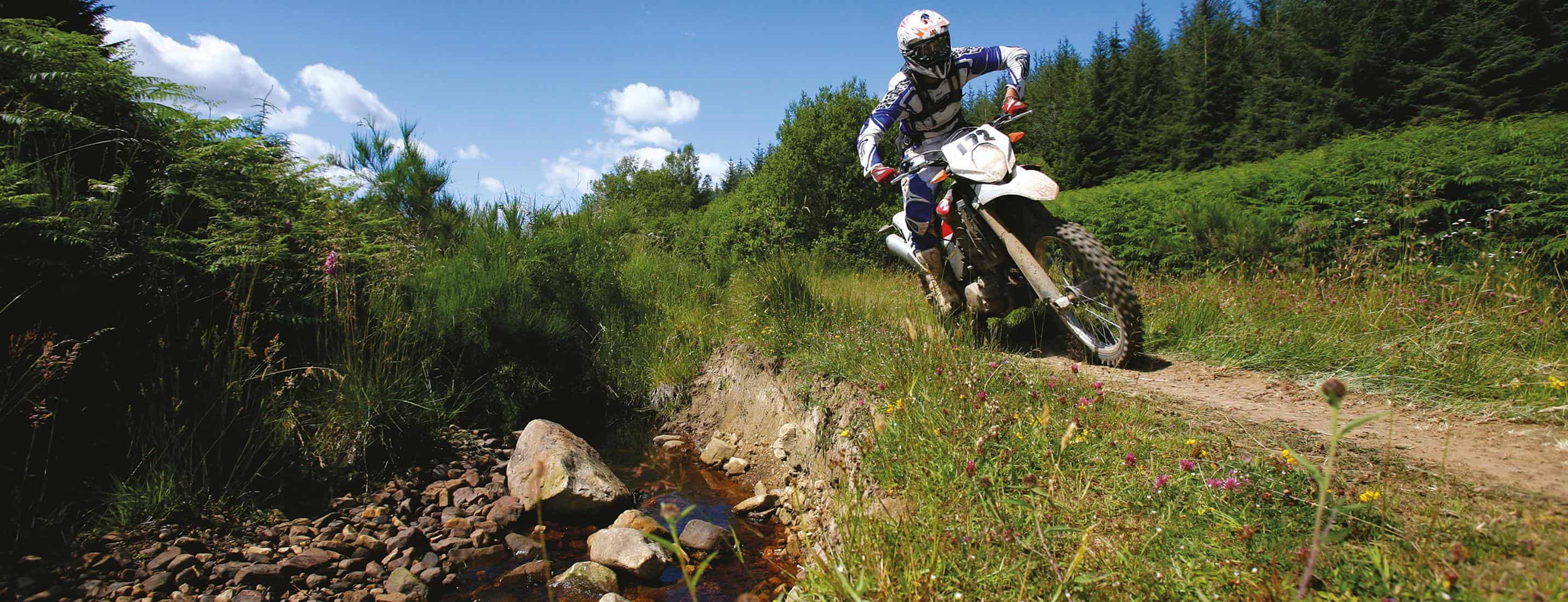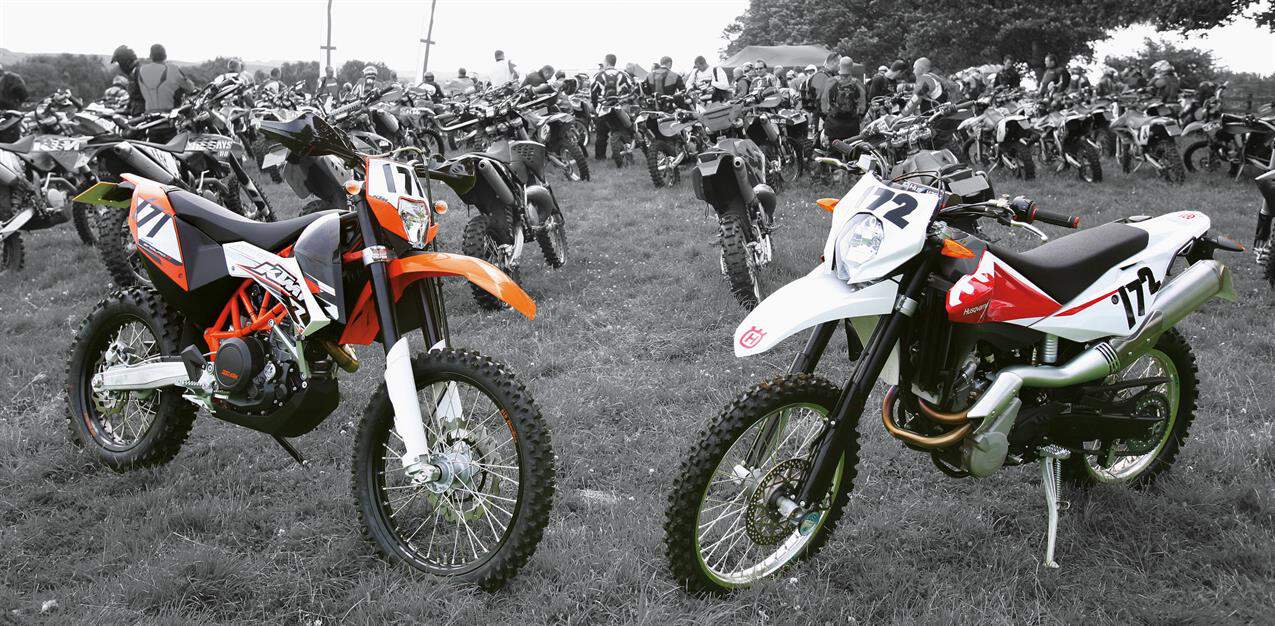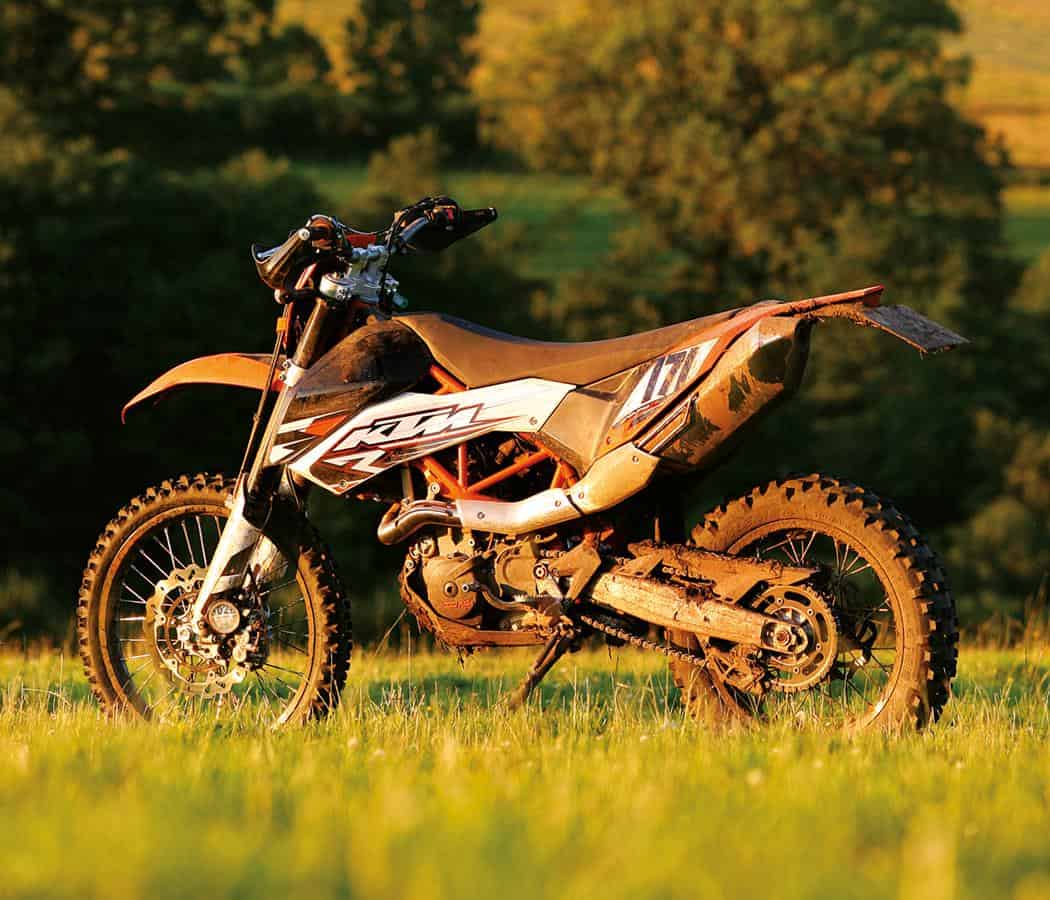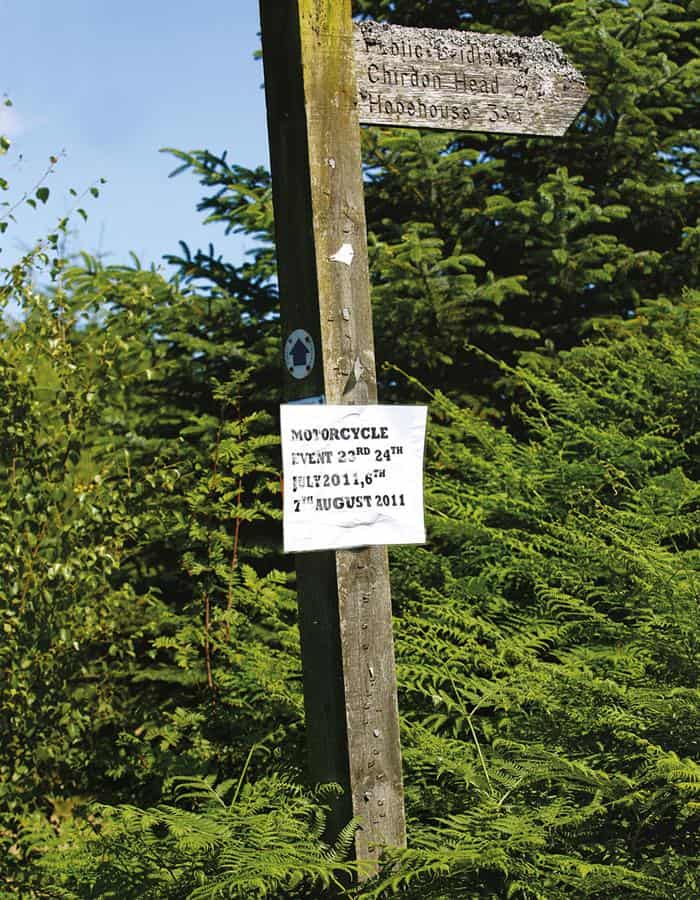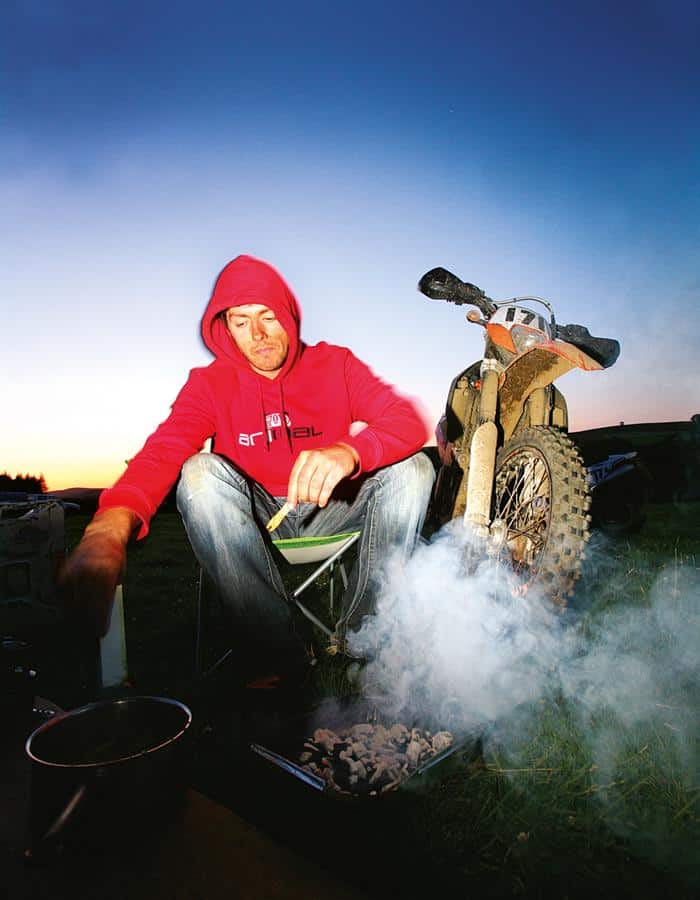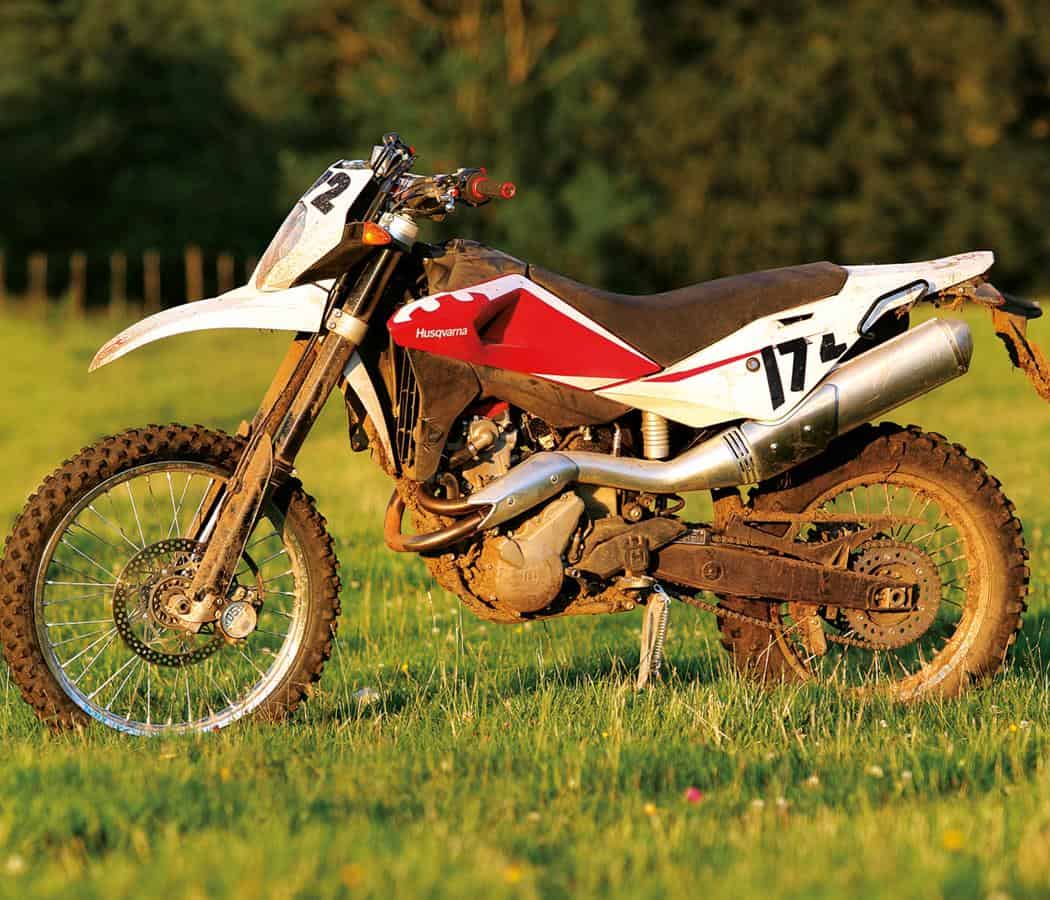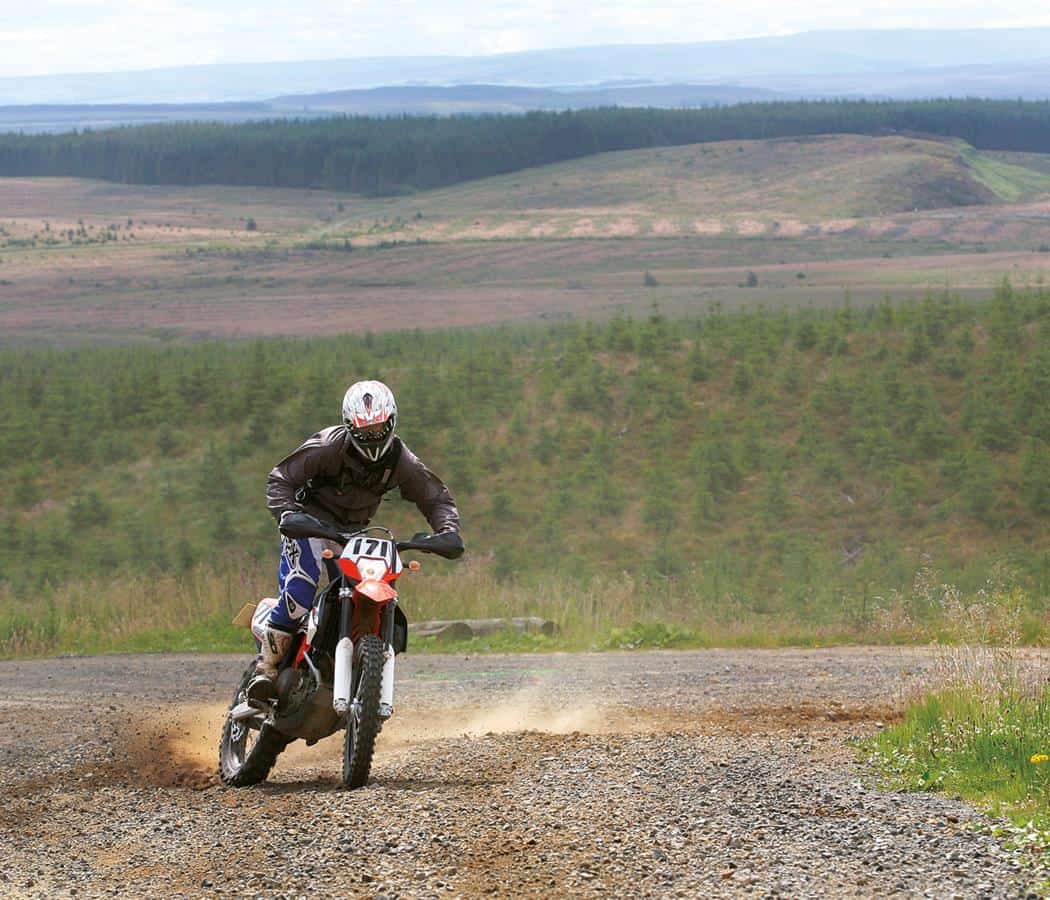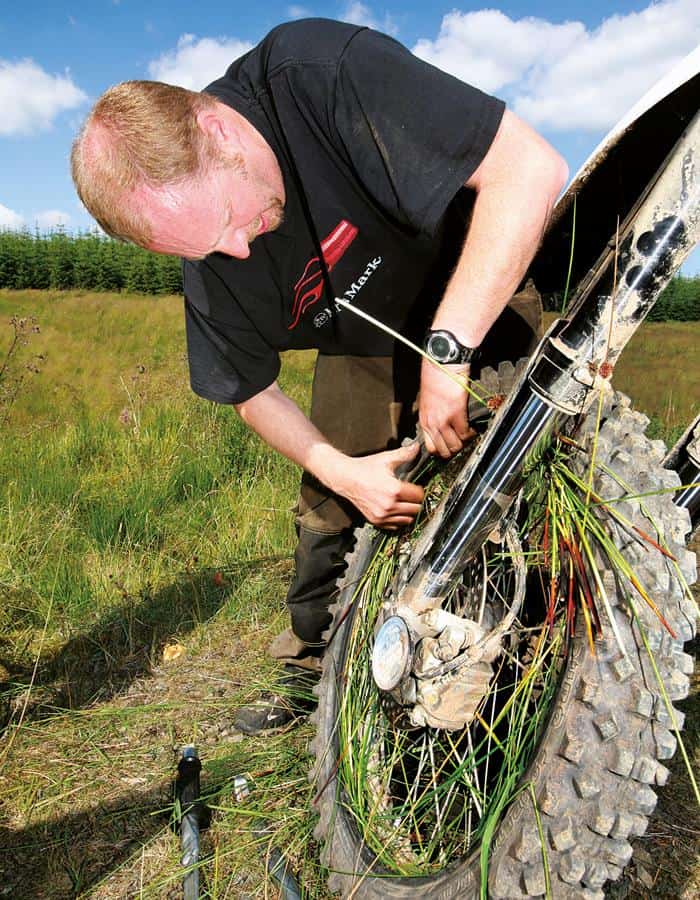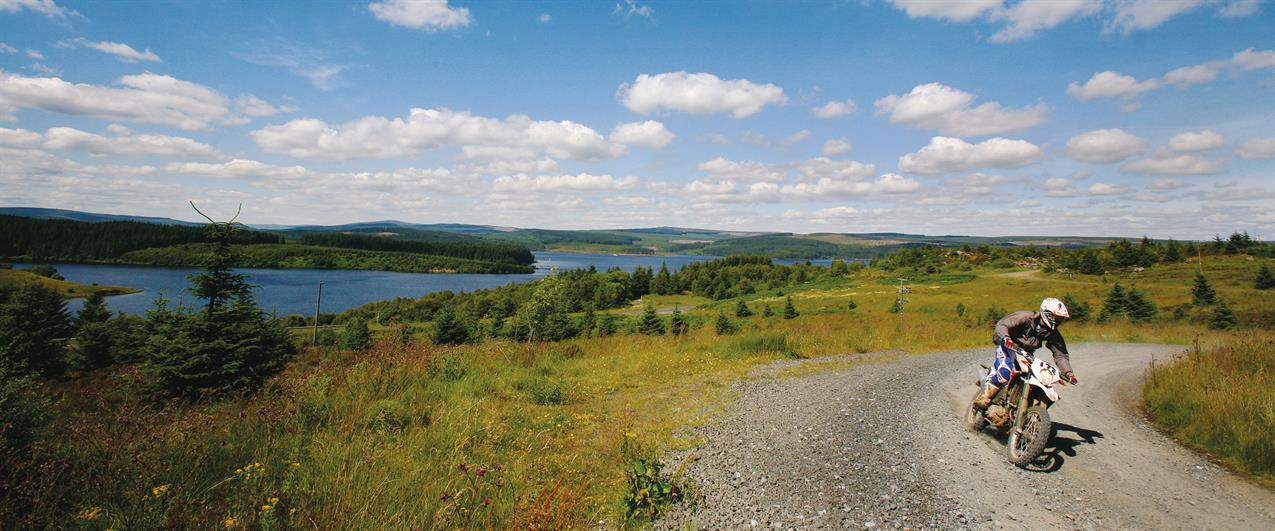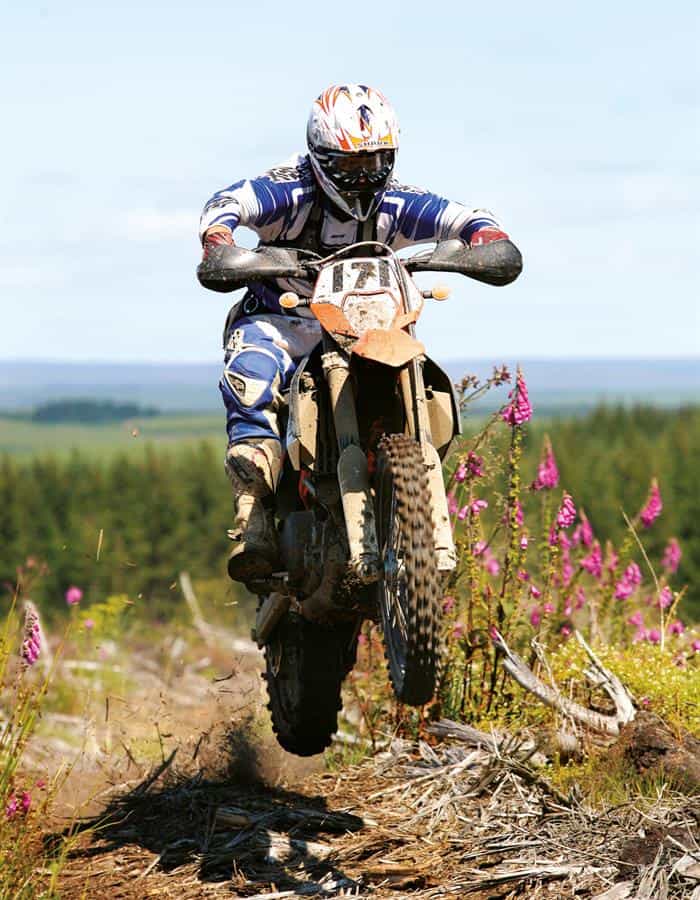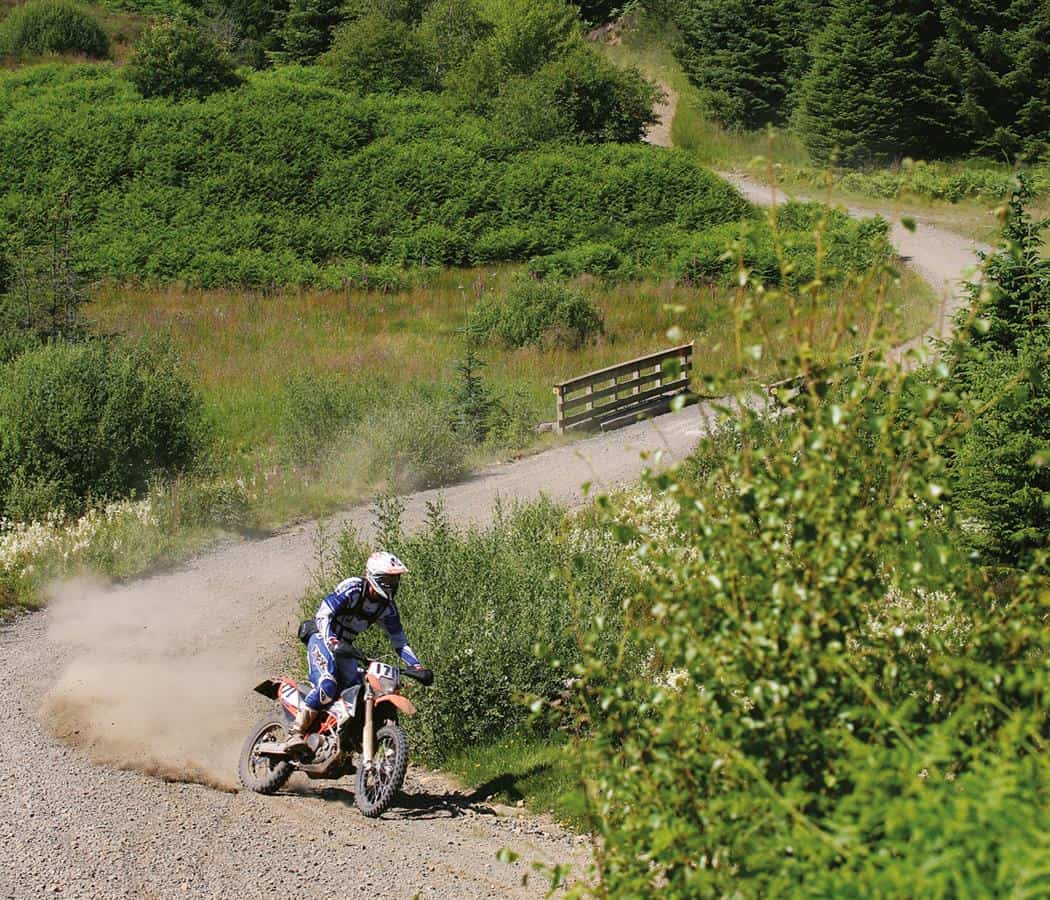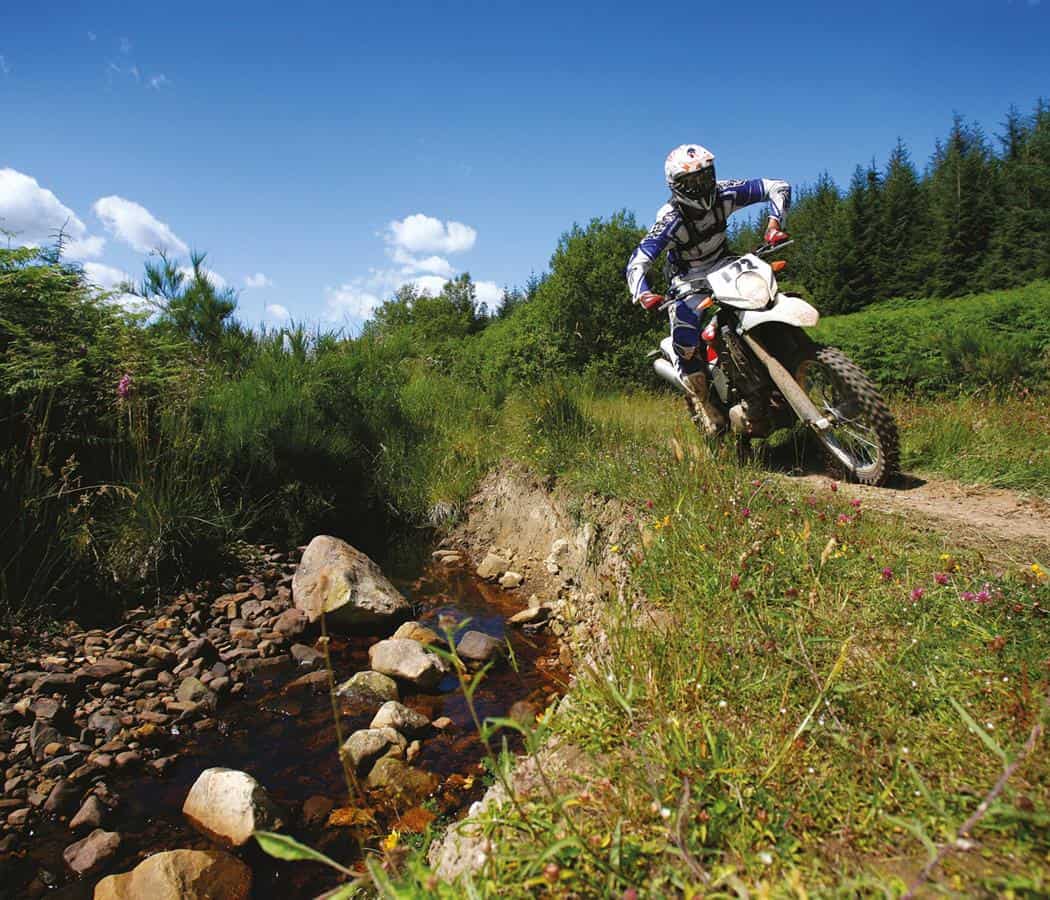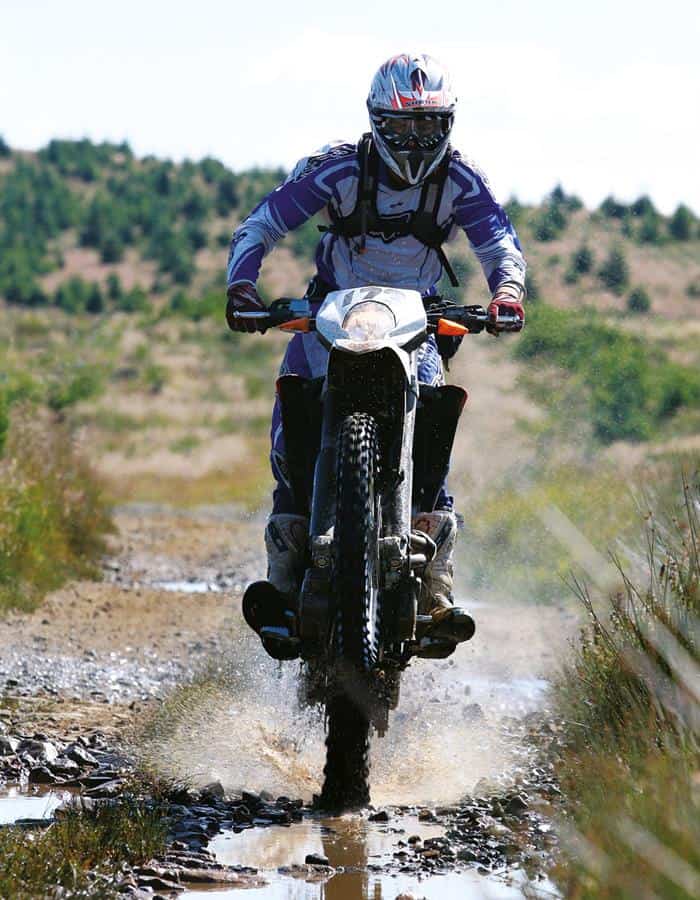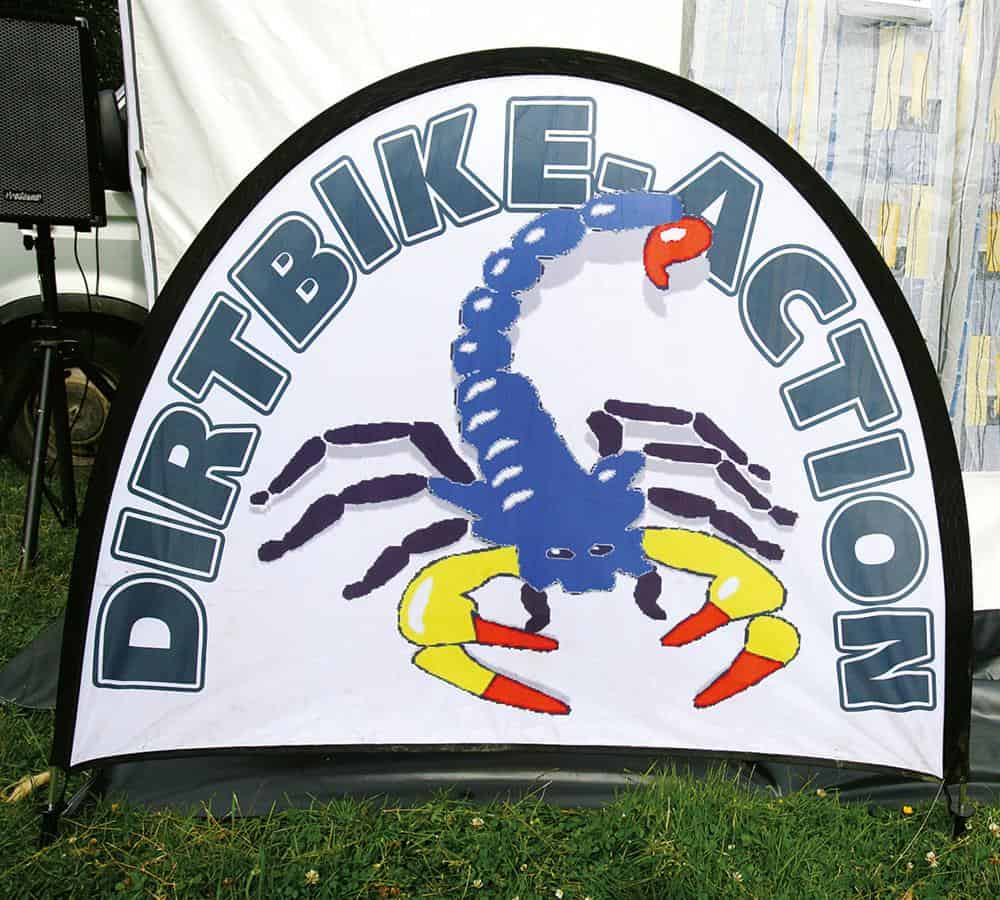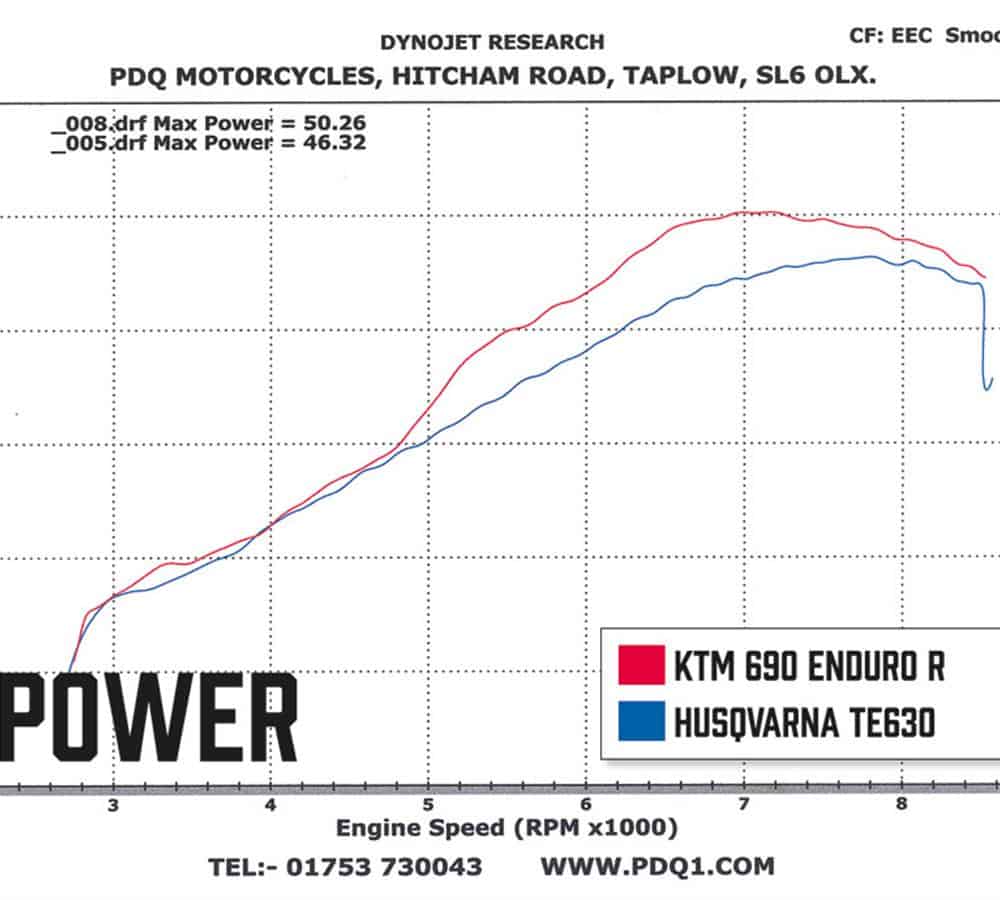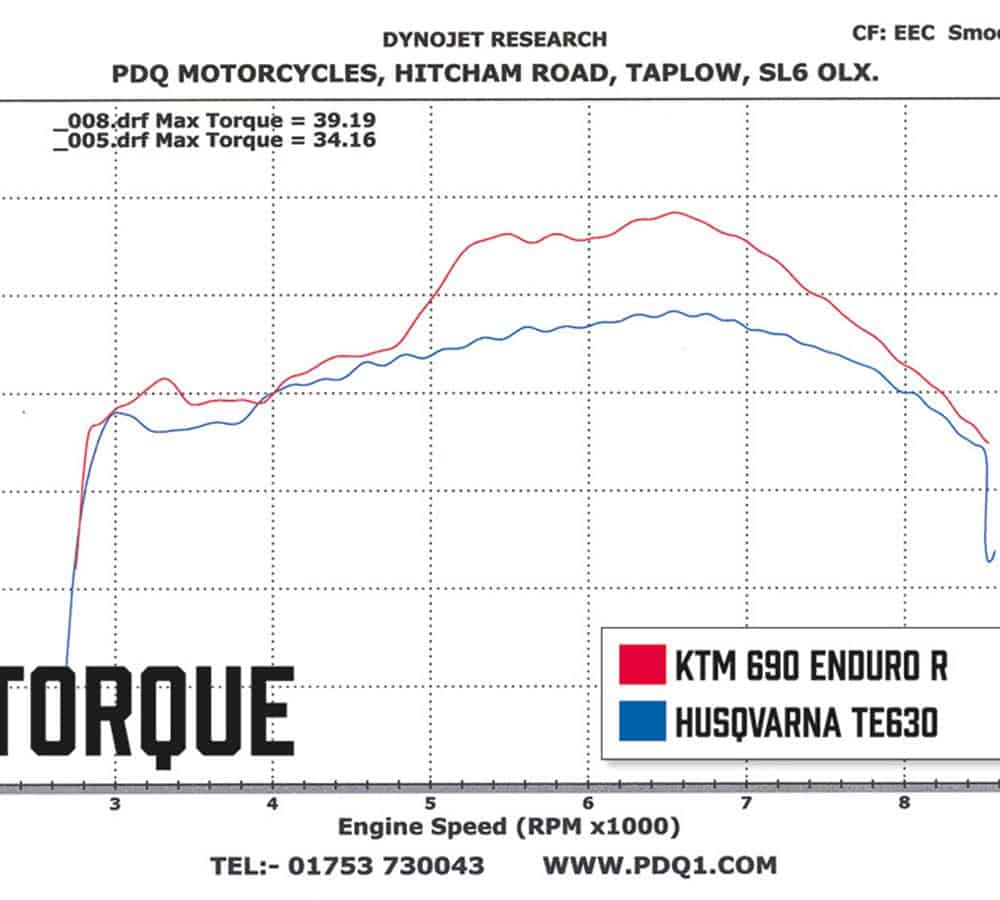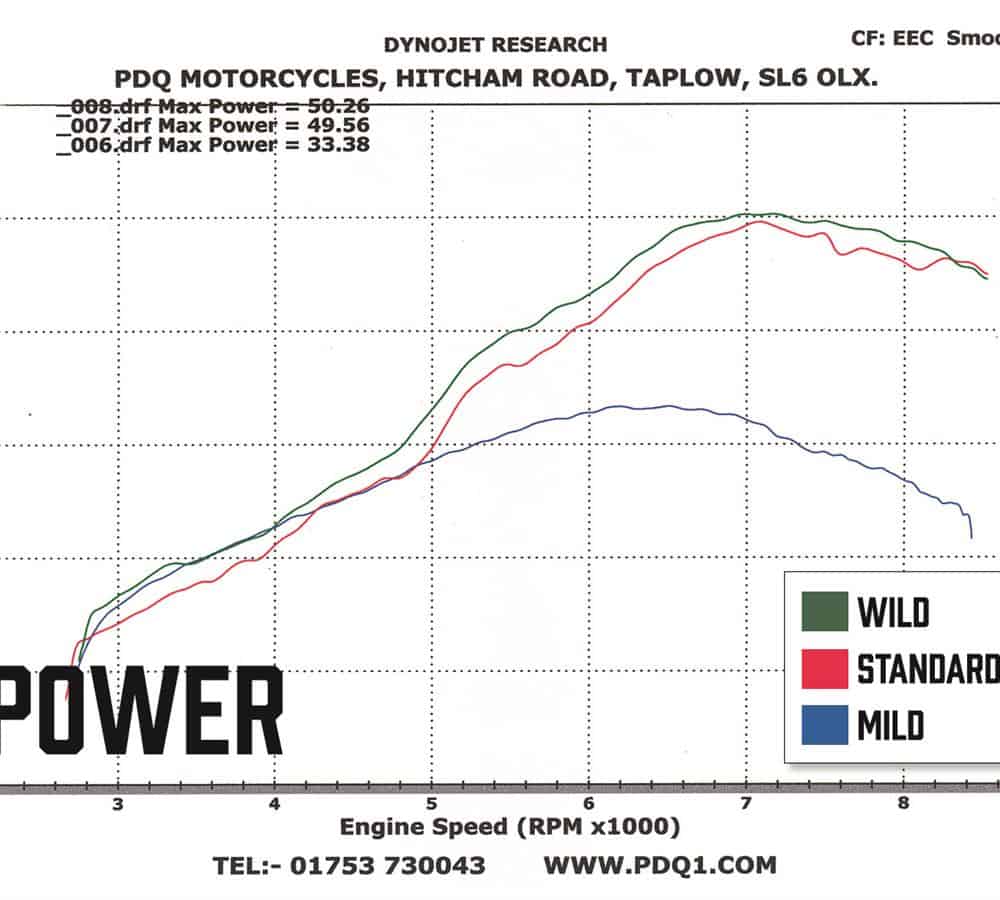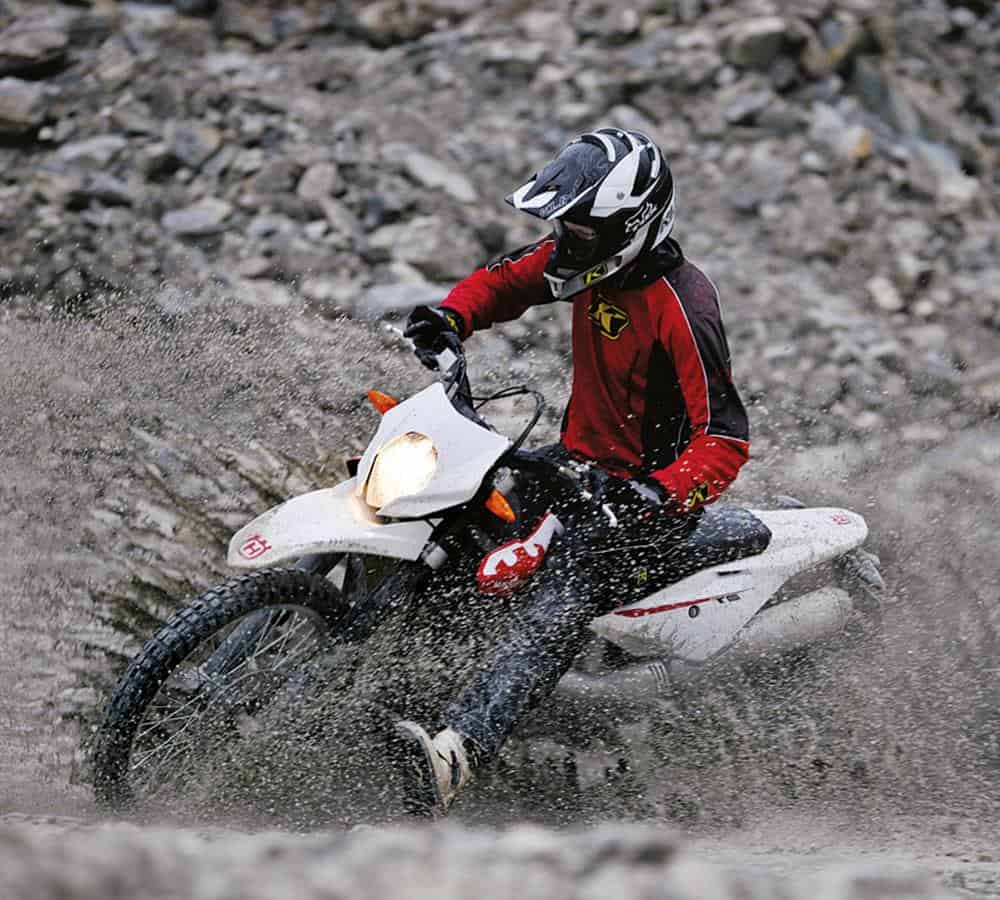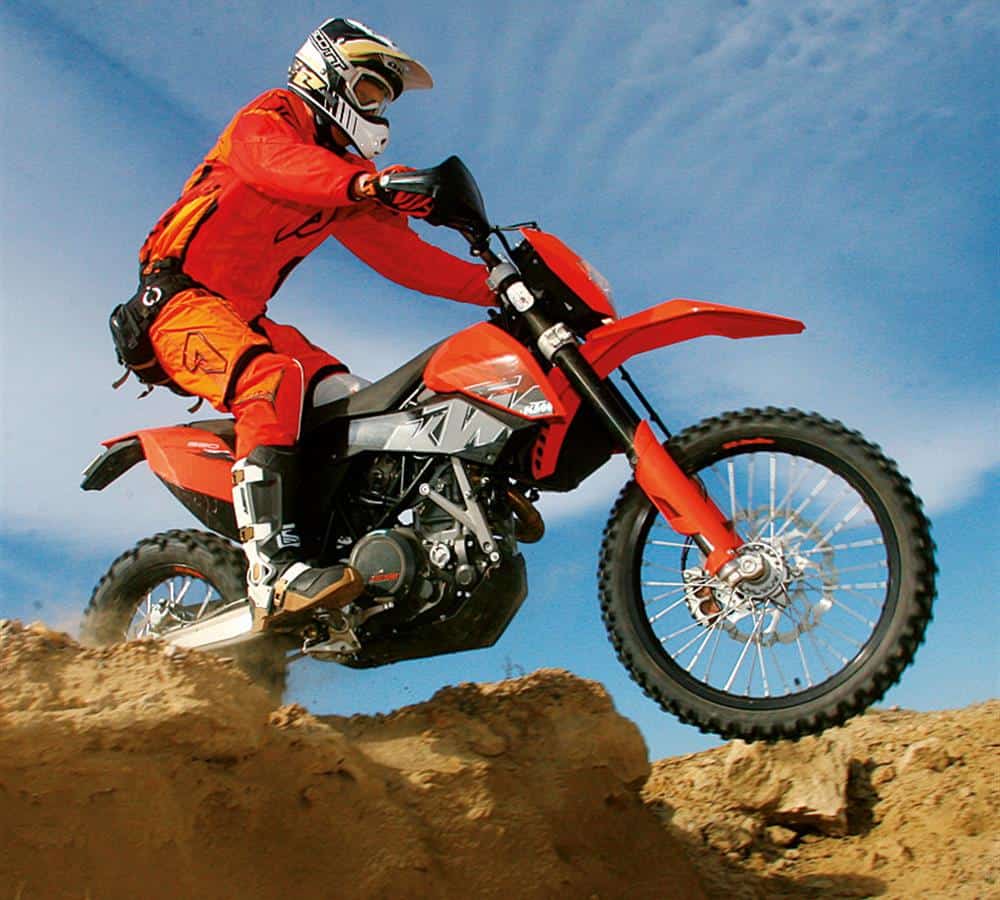Two big trail bikes, two riders, and a two-day rally deep in the north of England. It’s a dual-sport duel…
‘Don’t tell me… you’ve got a plan’, chortled Alex on the other end of the phone, as I ran through the logistics of our test. His time spent working at with us back in 2007/’08 meant he knew just how well Team RUST ‘plans’ generally panned out. This one was likely to be no exception.
‘Sure’, I replied. ‘If you get over here, we’ll head off once I’ve finished work on Friday (deadline loomed…). I’ve already got the bikes…’ Our destination? The village of Bellingham, Northumberland: the location for the Dirtbike Action K2 Rally and so far north that if you gave it a big enough handful you could roost Scotland. The bikes? Husqvarna’s TE630 and KTM’s 690 Enduro R.
Whilst the fairing-clad ‘adventure sports’ class continues to rise in popularity, ‘dual sport’ big trailies that aren’t swaddled in plastic bodywork don’t seem to have seen the same level of interest. Maybe it’s the lack of wind ‘n’ weather protection (a screen), or perhaps it’s that the simply don’t have quite the desired image – looking more like engorged enduro bikes than round-the-world travellers. Or simply that they fall into some kind of no-man’s land between the two camps. Either way, to dismiss them offhand is to miss out on some truly great dual sport riding, where you have both the power and poise for road miles, without the bulk or (painted) bodywork to excessively hamper you on dirt. And the 630 and 690R are probably the best examples of the current crop – just the tools for a UK rally!
Duel Purpose
Husqvarna launched the ‘new’ 630 in Spring 2010, the bike building upon the slightly dated TE610 platform. The styling was new, though not radically different to the old machine, and the chassis was largely the same. What really changed, aside from an improvement in build quality and detailing, was the motor. Or at least half of it…
The bottom-end is still pretty much the same as on the old 610, and the even older 610 before that… The top-end, however, has been fitted with a twin-cam head (from a ‘last generation’ SM510R supermoto) and an increase in bore size has lifted the displacement from 576cc to 600cc.
The 630 is the more ‘trail’ of the two bikes here, though by no means as roadified as something like an XT-R Yamaha. It may have pillion pegs and grab handles, small rubber-cleated pegs (swapped on our bike for something bigger/better/grippier), and a comfy seat but the launch test last year showed that the 630 was still up for some dirty fun.
The KTM appears by far the more off-road of the two bikes: taller, slimmer and lighter too. There’s no provision for a pillion and the clocks are less comprehensive than you’d expect from a ‘trail bike’. That’s because the R-model is the pared-down orange-framed off-road 690, whereas the regular 690 Enduro played the true dual sport role, what with its shorter suspension, more comprehensive clocks, and bigger headlight.
Launched in 2008, the 690 Enduro was the first KTM off-roader to use the new generation LC4 motor, by far the most technically advanced big-bore thumper in production. The fuel injected, SOHC, motor runs a semi fly-by-wire throttle, a slipper clutch and a switchable ignition. And the innovation doesn’t end there, as the bike also employed a self-supporting plastic rear subframe/fuel tank. This year, the Austrians decided to trim their range a little and the standard 690 Enduro bit the dust, leaving just the R-version.
Plan Ahead
Upon arrival at the RUST office, Alex picks at a loose thread in my plan, and starts to unravel it. ‘By the time we get there it’ll be one in the morning, we’ll wake up half the paddock trying to pitch the tent in the dark, get no sleep, and still have to prep the bikes. Let’s sort the bikes now, get some sleep, and then get up REALLY early and drive up in the morning.’ That all sounds darned pessimistic to me, but I have to concede that I fancy a beer and a pizza more than a motorway services sandwich and a hideously overpriced coffee. So I give in…
As my alarm screeches I can barely believe that I’ve agreed to Alex’s revision of ‘the plan’. Its bright red display shows 02:30! We have to be on the road by three at the latest, as scrutineering opens at 08:30, and we have AT LEAST a five-and-a-half hour drive to get there. Boy, am I glad I didn’t decide to ride up to Northumberland! The van’s loaded up with bikes, tools, tent, camping gear, and food. I’m loaded up on a quadruple espresso…
It’s not often you hear this, but Leicestershire looks beautiful as we fly through it on the M1, the sun’s just about to pop his head up over the horizon and the fields are buried somewhere under a blanket of mist. As we head into Derbyshire the sun starts burning off the airborne moisture and only ghostly pockets of it remain, lurking in sheltered field corners or adding an eerie edge to clumps of woodland. Unbelievably, I’m appreciating the early start.
Our caffeine-fuelled blitz continues northwards, past Catterick Garrison, Scotch Corner, and other A1 landmarks I’d normally consider ‘bloody miles away oop North.’ We’re soon in Newcastle, before turning east into Northumberland with the city’s terraced streets and iron bridges disappearing from view as soon as we crest the first hill. Fabulous open countryside lays ahead.
Finally, we trade the seemingly endless miles of dual carriageway for a wending B-road which even in a van gets us buzzing more than any cup of coffee ever could, and leads us the final few miles into the small town of Bellingham.
As we crawl into the paddock, weary faces are emerging from tents, and there’s a subdued chatter as bikes are prepped, kit is donned, and tea is drunk. We sign-on, buy some race numbers, and eventually line the bikes up in their allotted row at the startline. Our late entries put us alongside smaller lighter enduro tackle rather than the big bikes at the head of the pack, with just a couple of bikes behind us before the quad entry…
First bike away is at 10:00, we’ll be starting 40 minutes behind them. We spend the time snapping some photos and trying to raise the gearlever on the Husky – a simple job on any other bike but one which takes a good few minutes, such is the lack of easy access.
Once the big bikes and the trailies up front have headed away the legions of enduro machines start to disperse and pretty soon we’re outta there too, heading towards Kielder Forest along a humpy singletrack road that’s the perfect way to get us into the day…
Lap one. Husqvarna TE630
‘Bar risers’, I think to myself the second the Husky’s front tyre leaves the tarmac and I stand up on the pegs. ‘That’s something else we needed.’ We hadn’t managed to get any mousses fitted either, but right now I was finding the stretch down to the black braceless bars a little further than I’d like. Ho-hum, another area where the TE shows it self to be more road than off-.
The trail winds through the forestry, and the ground under tyre changes with every turn. One second we’re on gravel fireroad, the next hardpacked sand, and then turn a corner and it looks as though someone’s tipped two-tonnes of railway ballast across the apex. The trail flows wonderfully, rarely remaining in a straight line for longer than a few hundred yards, before leading us out onto yet another section of tarmac, running up to the first checkpoint of the day.
It’s too early to make any meaningful comparisons between the two bikes, but that doesn’t stop us gibbering away about ‘em anyway. We chat with the riders who are on our minute, and shuffle forwards along the track until the time clock shows that we’re up next.
Tarmac again gives way to fireroad, and the first turn nips-up deceptively as it drops away downhill. The Husky drifts a little wide, I look at the drop off the outside edge, gather my composure, and pull it back towards the inside with a dab of rear brake and a dash of throttle. As the trail runs down the hill, the view opens out and allows us to push on. Having to shoot pictures during the event means we need to try to make up some time on the going so that we aren’t dead last, stuck behind a dozen quads! I strike a pace that means we can keep good time without buzzing fellow riders like an Apache-pilot on a gun run, and Alex follows suit.
A bumpy twin-track drops us down onto another section of fireroad. I make the 90-degree turn onto the shaley track then gas-up the 630 and pull a few yards on the bike ahead. He disappears around a turn, then, well, disappears. Arriving at the corner I look off the outer edge of the track to see a WR-F caught in a fence below, its rider trying to extricate it from the mass of wire and lift it clear of the sturdy post it’s wrapped around. I park-up, clamber down the bank and help him drag the bike out whilst Alex waves down following riders so that no-one takes us out. As we head off, I glance back to see a quad go sailing straight off the edge in exactly the same place…
By now I’ve got used to the Husky’s low bars, its wide bodywork and reasonable bulk, and start enjoying the reassuring stability and the easy manners it exudes. The trade off is that it takes a bit of a shove to get it turned into the corners, though I can live with this on fast fireroads, where the bike remains resolutely planted through the bends.
An arrow points us off the fireroad and onto a rocky twin-track across open clearfell. All around lay lifeless white branches bereft of bark, beige marsh grass and deep pools of oxide red water. The route is well established, straight and fast, where every bump (and there are lots of ‘em) is followed by a sizeable puddle. It’s a fine test of the bikes’ poise and suspension, so I give the Husky its head.
The 630’s suspension is a curious mix, with Marzocchi forks running a claimed 270mm of travel whilst the Sachs back-end features a far more enduro-like 320mm. Neither end is set-up particularly firm, so I have fun trying to keep it in check as I bound from bump to bump using up a good proportion of the suspension travel, whilst simultaneously avoiding the rocky edges and large stones which seem to frame each puddle.
Despite a few heavy landings the suspension never truly bottoms-out and the Husky tracks pretty straight. I would firm up the front-end but sadly this option isn’t available to me – the forks only offer rebound adjustment – so instead I simply make a mental note not to hit obstacles TOO fast.
The course includes three ‘Rally Plus’ routes – optional hard routes for those who want a little more of a challenge – and we pull up at the first of these to be greeted with a scene of mild carnage. In the woods to the side of the fireroad are the three quads that’ve got ahead of us, and they’re either stuck fast or wedged tight between trees. The young marshal eyes our bikes and helps us make a decision. ‘I wouldn’t bother on those’, he suggests, ‘you’ll just sink.’ Indeed, as we pull up to the refuelling check a few miles further around the course a number of bikes are utterly clarted in a porridgey mix of thick black mud and bog grass.
After the check comes the events one and only special test. Alex is away first on the KTM, and as he disappears out of view the timekeeper gives me the nod and I gun the 630. Two ruts lead into the forest, and they’re wide enough to keep the throttle pinned but bumpy enough to make you think twice about it on the very first lap. Still under the trees, the ruts give way to a slippery trail, which winds between the conifers before leading out into the open amongst boggy clearfell.
Looping around to run across this wide expanse of brash, the track’s surface is firm yet punctuated by occasional dug-out puddles. At pace the Husky demands a good pull on the bars and a handful of throttle to lift the front wheel, ideally complimented by a whisp of clutch if you want to really hoik it up.
Through more slippery woods, the test ends with a charge down a hardpacked track, ten yards of squidgy whooped grass and a climb up a bank out onto the gravel tracks. All-in-all there’s nothing TOO fast – no flat-out-in-top fireroads – but nothing too technical either. I’m looking forward to trying it on the Katosh…
The next ‘Rally Plus’ section is singletrack across clearfell, whooped-out but easy to negotiate at speed. In fact, even on a 150-kilo bike the ride is far smoother at a pace, rather than a sea-sickness inducing crawl over the bumps.
The weight of the bike soon makes itself felt when we arrive at the course’s one-and-only bog. A handful of people are dragging their bikes out of the gloop, so we stop and survey the terrain for a few moments. I’m planning to bypass the morass with a wide line, when Alex spots a small metal sheet used to form a small bridge spanning a murky stream. My intended route turns out to be part bog, part Nile delta. So I choose the other side, almost hugging the treeline, and it works right up until I’m faced with a log to cross. I build some momentum, lift the front-end, and then dip the clutch as the rear wheel starts to roll over it. The front drops… then stops. What I hadn’t seen was a chunky branch laying on the other side, perfectly positioned so that it’d stop the front wheel with the rear tyre resting on the log. Helpfully, a chap who’s just cleared the stodge parks-up and moves the branch, allowing me to manhandle the Husky over the log (using those handy, if nasty-looking, pillion handles) and ride clear. Alex, meanwhile, is in the middle of the bog, trying to extract the rear wheel of the KTM from its grasp whilst simultaneously trying not to burn his gloves on the cat-equipped silencer or get them too covered in mud. Curse the 690’s sleek rear-end.
The third Rally Plus route takes us deep into the forestry, where the ground is spider-webbed with white roots and the course is just wide enough to get handlebars through. Pick a rut and follow it…
Here the Husky fuels far better than on the launch, where it suffered from a low-end stutter and a propensity to cough stall at very slow speeds. This trait hasn’t been entirely eradicated, though it is far better than I remember, and along with the improved fuelling I’m also impressed with the traction that the bike generates. Despite the twin-cam head, the power isn’t overly peaky and the 630 will happily chug its way out of trouble. I’m little short of amazed when it claws at the slippery climb out of a stodgy ditch and continues up the muddy hillside without spinning its rear tyre.
A descent onto fireroads brings welcome relief from the slog through the plantation, and takes us towards the end of the 60-mile lap, where I swap onto the KTM.
Lap Two. KTM 690 Enduro R.
Taller, firmer and slimmer – and that’s just the seat! Although the spec sheets suggest that the bikes are the same height, they aren’t. Where the Husky felt like a trailbike the KTM feels more like an oversize competition machine. The lighter weight is immediately obvious, as is the more aggressive riding position and the big step in power once you’re spinning the motor into its mid-range.
Despite packing 654cc of firepower, there’s very little bottom-end oomph from the 690 and if you’re expecting it to be a traditional stump-pulling single like the XR650 then you’re in for a surprise. Like their LC8 V-twin, which is much revvier than traditional vees, the LC4 motor requires a few more revs to really bring it to life. But you soon learn that, because holding it open reveals an incredible mid-range surge that builds into a fantastic top-end.
The same fireroad corner which nearly caught me out on the Husky again brings a nervous moment, not because I hit it any faster on the potent KTM but because I realise that the KTM’s front brake isn’t as sharp as the TE’s, despite its bigger floating disc. Thankfully its steering IS sharper, and its chassis more responsive, and that makes it easy to change line mid-turn.
The 690 is an utter joy on the firebreaks, especially those where the course winds through a series of sweeping turns. Stood up, weight forward, you can easily steer the bike through the pegs, before adding some opposite lock when the back-end drifts out, or countersteering to pull a tighter line. It isn’t as planted as the Husky but it requires far less in the way of input.
When we reach the rocky, puddle-strewn track, I up the pace and put the 690 through the exact same test I did the 630. Although the KTM runs 275mm of travel at both ends it is both sprung and damped far firmer than the Italian bike and, while the forks are perhaps a touch harsh, it was far less troubled by the big dips and high speed yumps and didn’t feel as if its weight and momentum was likely to get out of hand.
It’s less impressive when we reach one of the few parts of the lap where the ground is sodden. On slippery mud, slick grass and wet stone the bike is more of a handful than the Husky, as the front-end kicks off the bumps and slithers through the slop. There’s little point in us softening up the suspension though, as the rest of the lap is bone dry and much faster.
A brief section of road runs us past Kielder Water, where sailboats gleam in the summer sun set against the Royal Blue waters. As I turn off into the entrance to the forestry Alex pulls alongside announcing that he’s got a flat front tyre. Dammit. We’re not carrying a spare tube, nor the giant-sized Allen key required to undo the Husky’s front spindle (and it doesn’t come with a toolkit), but we do have a can of tyre sealant… which comprehensively fails in its task!
We tell ourselves that the next check can’t be too far away, and crack on with Alex taking the lead to set a pace that he can ride at. He puts on an outstanding display of how to handle a bike with a flat tyre, hanging off like a roadracer through the corners to keep the bike upright and the tyre on the rim, though the check is much farther than we thought.
We accost Martin Wittering from Torque Racing (spannering for the Desert Rose riders) to see if he has a tube, but all of their bikes are on mousses. He offers to help with the old Dakar trick of stuffing the tyre full of grass – there isn’t time to cram too much into it but if it’ll help keep the tyre on the rim then that’s cool with us. Harvesting handfuls of trail-side foliage generates some very strange looks…
I pull up to the line at the start of the special looking forward to the ride ahead. It was fun on the Husky, so it should be even better on the 690. ‘You can go when you’re ready’, suggests the timekeeper and I fire the KTM down the rutted trail. Up through the (notchy) gearbox, I’m focussed on the first turn when I hit an unseen rock with the front wheel and the impact clangs ominously up through the forks and into my wrists. I think little of it, and go back to my task of catching the bike in front. Almost as soon as I’m past him I stall the bike going into a turn and run wide, but it fires up straight away and I manage to exit the corner ahead of him.
Coming out from under the trees onto the harder ground I push even harder. The KTM inspires you to push harder. On the approach to an open S-bend I drift right to set myself up for the initial lefthander and then tip it in towards the apex. Whoooah sheeeeeet! The bike is having none of it and instead ploughs straight on into the undergrowth. It happens so quickly I don’t have time to think before I’m bisecting the track in the middle of the ‘S’ and careering off to the left. I plough blindly through the tall grass, steadily scrubbing off speed when it suddenly dawns on me that I might get away with this. I mean, you don’t often run through this kind of undergrowth without hitting something immoveable, generally a log or tree stump. It’s at that very second that the front wheel drops into a waterhole and I’m fired straight over the bars! A soft landing and hit of adrenalin means I’m okay, plus the bike’s unscathed and remarkably easy to remove from its boggy resting place. I can hear the guy I passed approaching and instead of questioning my unplanned excursion, I fire the 690 into life and emerge from the shrubbery as he pops into view. I last about 20 yards before exiting the track at the very next corner! Remarkably, I get away with it again, only this time it dawns on me: I too have got a flat front tyre…
That square-edged rock was doubtless to blame so I limp the KTM to a safe spot and wait a few moments for Alex to arrive, reasoning that if another racer comes across two slow moving bikes in the middle of a special test, it’s better that they’re together, and we make our way along the course, moving to the side whenever we hear anyone approaching.
A quick conflab with the marshals and we decide to ride the course back to the finish. It’s about the quickest way back, and it also means we’ll be credited with a ‘finish’ for the day even if both our test times are completely shot.
Back in the paddock I’m shocked to discover that not only have I forgotten our spare tubes but also any cutlery with which to eat our pasta dinner. Disaster! So having begged and borrowed a pair of tubes (plus the necessary tools to extract the Husky’s front wheel) from around the ever-friendly rally paddock, and mended the two tyres, we eventually sit down to eat using wooden chip-forks from the catering tent. This certainly wasn’t part of the plan!
Morning has Broken
Sunday morning and I’m hobbling around. I must’ve collected the bars with my thigh as I flew over them and putting any weight on my right leg is decidedly uncomfortable. Alex is also somewhat detuned – a stone fired from the Husky’s rear wheel has potentially put an end to the Gausden bloodline.
Following a quick brew from the camp stove (which curiously tastes like pesto…) we prep the bikes and push them up to the startline. Our new HD tubes will doubtless help keep further punctures at bay, but even so we’ve pumped the tyres up a few more psi, just in case.
Lap three. Husqvarna TE630
Whilst my aching leg would rather be on the KTM – with it’s slightly more generous peg-to-seat height, higher bars and more responsive chassis (weighting the right-hand peg through corners isn’t easy) – the Husky is a good way to ease into the day. It feels safe and secure.
Even early in the day the sun is blazing hot and there’s preciously little breeze, meaning dust hangs in the air and makes it harder to follow people. Alex hangs back, as much in fear of copping another stone to the groin as avoiding eating dust…
Brake-sliding the 630 into slow turns is great fun though not always necessary in order to get the Italian bike sideways into corners. There’s quite a lot of engine braking from the 600cc motor and banging it down a solitary cog without perfectly matching the engine speed is enough to get the back wheel locked and skating across the dirt. It’s fun when you want it to be, and a little awkward when it catches you unawares.
Neither bike responds too well to the increased tyre pressures though I really notice the difference on the 630. With grip diminished, the relaxed geometry of the TE doesn’t feed quite the same level of information back to the bars, and I’m forced to slither around in those muddy sections where the bike felt totally at ease the previous day. On more than one occasion a quick dab saves me from having to right the 160-kilo machine.
When we reach the special test I avoid the rock I hit the previous day by taking the unused left-hand rut away from the start. It doesn’t set me up for the lefthander ahead, but I don’t suffer another puncture either…
Despite putting in a scrappy performance on the test I’m genuinely warming to the Husky. It doesn’t have the sporty feel of the KTM so it’s surprising just how hard you can ride it without tying it, or yourself, in knots. The softer suspension and less immediate power delivery also cosset tired limbs rather than trying to separate them from your torso. Still, I’m looking forward to another go on the 690…
Lap four. KTM 690 Enduro R.
I never tire of high speed, sweeping trails and the KTM laps them up too. Although there’s a far more distinct powerband than on the Husky, the motor is less vibey and more refined (even if it does sound a little rattly at idle). It’s ideal for high speed, up-on-the-pegs mile-munching and picks up speed in a wonderful manner, revving freer than most big singles. Alex settles onto the soft seat of the Husky with a contented sigh – ‘ah, the comfy sofa.’ That’s not a criticism, as we both know that the 630 is the more cosseting and forgiving of the two.
As the course has matured, and we know exactly where we’re going, it doesn’t take long to get past the slippery muddy sections (the sharp geometry lessening the effect of running higher tyre pressures and giving better feel than the 630) and round to the special test. We splash some fuel into the bikes’ 12L tanks and line-up at the start…
Tiredness manifests itself in missed gears out of slow corners (I frantically stab at the lever rather than letting it return properly and end up bouncing the motor off the limiter) and some pretty curious line choices. Then, heading into a loose gravel turn I stall the motor. Really, I should’ve just banged down a few gears and let the rear drift around in the kind of smooth controlled manner that the slipper clutch allows. Instead I use too much rear brake and snuff out the LC4’s fire.
I’m still rolling but as I thumb the starter it fails to engage and instead taunts me with a horrible graunching noise. Coming to a stop, the engine finally catches and I gas it up, losing all composure and any semblance of a smooth ride.
Charging across the brash, my view ahead obscured by red mist, I suddenly remember about a section of deep sticky goop just in time to see it hove into view. Lap-on-lap the mudhole has been dug-out, and now features deep wheel tracks in amongst its crisscross of branches. I’m too close to it to slow down and pick a good line, so I focus on a point on the far side, frantically bang down a couple of cogs and crack the throttle. The motor spins hard and the 690 hoists its front-end clear of the hole, dropping it back down to earth as the rear wheel is sucked into the quagmire. I brace for the inevitable swapping off ends and taste of fresh dirt but it never comes. The chassis soaks it up and shrugs it off. It’s this responsiveness which makes the Enduro R so good to ride off-road.
Once clear of the special test there’s only a few more miles of the lap left, before the run back to the paddock. We knock the pace down a few notches and revel in a beautiful summer day, out in what feels like the absolute middle of nowhere. There’s plenty of time to appreciate the slatey singletrack that feels almost Pyrenean and my personal favourite stretch of the entire course: a winding grass track which mirrors the meandering of a nearby stream. Despite our tribulations, we end the event on a high.
The Crown Duels
In terms of which is the better bike for off-road competition, the KTM is the machine to pick. It’s lighter, better suspended, quicker-turning, more powerful, and more responsive than the Husky. And I’d certainly take the Enduro R over more demanding terrain than I’d aim the Husky at. But that’s by no means game, set and match to the Austrian. Because the Husqvarna surprised us by matching the 690 for pace around the test (even if you did have to work a bit harder), and by being far more rideable than expected. It didn’t come close to matching the 690 for ‘dynamicism’, but had it rained then I expect we’d have been enthusing about its linear power and plush suspension, whilst the KTM slithered around on its firm springs, going sideways almost everywhere. And although the KTM’s LC4 motor is incredibly smooth, the soft seat and compliant suspension of the TE630 mean it can match the Austrian bike for road manners. You can even take a pillion – not an option on the KTM.
Both bikes come with a two-year warranty, though KTM add to that with two years European breakdown cover – damned handy if you fancy a jaunt onto the Continent to sample the trails of France or the tracks of Portugal.
The 630 is currently around a grand cheaper than the 690R, and I have to say it does look the less expensive of the two. There isn’t quite the same attention to detail, specification nor feeling of quality you get with the 690. And you’ll spend some of that difference fitting items such as better pegs (already sorted on our bike) and lifting the bars. Nonetheless, that £1000 will probably get you those parts, plus a year or two’s insurance, a couple of sets of tyres and a few tanks of gas.
So whilst the KTM is the more lively, more focussed and more intense, the Husqvarna appeals because it isn’t quite so lively, focussed, and intense! One of these bikes will almost certainly fulfil your dual sport requirements. Which one it is depends on what you’re planning to do with it…
Thanks to the following for all their help: John Kerwin at Dirtbike Action. Dave Plummer at Husqvarna UK. Stuart at SS Racing. Ross Walker at KTM. Martin Wittering at Torque Racing. Craig Bounds at Black Desert. Patsy Quick at Desert Rose. Derek Edmondson at Edmondson Racing. Cheers folks!
Action Stations
The K2 Rally is run by Dirtbike Action, an ACU-affiliated club running events predominantly in the north-east. Alongside the Kielder-based rally, Dirtbike Action organise a wide variety of events to suit a range of abilities – including some traditionally tough timecards.
Earlier this year they ran a round of the British Enduro Championship, and they host rounds of the North East Enduro Championship. Enduro practice days are held regularly, and Graham Jarvis riding schools also featured in their 2011 calendar. Come harvest-time, the club run ‘stubble-x’ events on the area’s rolling farmland and if you’re into that feet-up malarkey, then trials riders are catered for too, with a round of the British championship amongst the dates!
For information on forthcoming Dirtbike Action events visit www.dirtbike-action.co.uk or call 07557 665647.
DynoMight
Even without riding the bikes I had an inkling which machine would claim dyno superiority. KTM’s latest generation LC4 lump is renowned for its prodigious power output and the first of the breed that we’d tested on the PDQ’s Dynojet dynamometer – the aesthetically-impaired 690SM supermoto – punted out a whopping 60.5hp and 46.8ft-lb of torque. We knew that the Enduro wouldn’t match that figure, especially as compared to road hoops dirt wheels/tyres generally rob a bike of a handful of rear-wheel-hp, but as Husqvarna were CLAIMING 54hp for their 630 motor then it was unlikely that the TE would come out on top.
And sure enough, peak power for the Husky was 46.32hp, whilst the KTM produced 50.26hp – ten percent more. Similarly, the 690 put out 39.19ft-lb of torque, to the 630’s 34.16. But that isn’t the full story…
Look at the curves that the (DOHC) Husqvarna produces. The power is fantastically linear, the torque curve remarkably flat, and that makes for a very rideable engine. There are no nasty surprises: no dips, stutters or flatspots.
At around 5000rpm the (SOHC) KTM’s curves rise like a new volcano emerging from the Pacific Ocean. One minute all is calm, the next you wonder where the hell all that pent-up force came from. Part of the reason for this split personality is the electric motor which controls the fuel injection’s butterfly valve, known as the EPT or Electronic Power Throttle. This motor is governed by the ECU, which takes into account the bike’s speed, throttle opening, which gear it’s in, the alignment of the planets etc, before deciding how much it should open the throttle valve. Should you, for instance, suddenly crack the throttle from a standstill or whilst pootling along in, say, second gear, the bike doesn’t give you full gas. ‘You silly boy, you’ll end up on your ass’, it says, and the motor opens the valve slightly slower. At other times this motor’s effect is less pronounced, and though it may still act to smooth out the drive (it’s primary function), the faster you’re going and the more fuel its flowing the less it interferes with what your right hand is asking for.
Click on any of the graphs to get the full image…
Another factor is simply the design of the engine. Unlike traditional big singles the LC4 runs a fairly light flywheel so it spins up quite quickly for a 650, and KTM wanted a sporty motor rather than a lugger. On top of that is the fact the engine has been designed with other models – 690SMC, 690 Duke etc – in mind. Even so, it’d be nice to have a bit more bottom-end oomph..!
The KTM also features a switchable ignition, offering a choice of ‘normal’, ‘full gas’ or ‘tedious’ modes. To change between these you need to turn the ignition off, remove the seat, and turn a small ‘wheel’ switch to one of three of its ten positions (the other seven effectively do nothing). Personally, I prefer the full power mode as the added power and increased throttle response throughout the rev range makes it easier to lift the front wheel over obstacles and it gives you a bit more of a buzz, though I know that some owners prefer the slightly less abrupt response of the regular ignition map.
In low power, the bottom-end is bizarrely just as strong as in full power guise. However this soon tails-off and this mode ultimately robs the 690 of almost 20hp, not to mention 25 percent of its torque. Unless you’re riding on greased marble in the depths of a Siberian winter it’s really not worth bothering with…
Husqvarna TE630
Price: £5807 OTR (When new in 2011)
Engine: Fuel injected, DOHC, e-start single
Displacement: 600cc
Bore & stroke: 100 x 76.4cc
Transmission: 6-speed
Frame: Chro-moly single tube cradle
Front susp: Marzocchi 45mm USD fork (rebound adj only, 270mm travel)
Rear susp: Sachs ‘Soft Damp’ shock (fully adj, 320mm travel)
Front brake: Brembo two-piston caliper, 260mm disc
Seat height: 930mm (claimed)
Wheelbase: 1505mm
Fuel capacity: 12L
Weight: 158kg (claimed, wet)
Contact: Husqvarna UK on 01293 771691 www.husqvarna-motorcycles.co.uk
KTM 690 Enduro R
Price: £6795 OTR (When new in 2011)
Engine: Fuel injected, SOHC, e-start single
Displacement: 654cc
Bore & stroke: 102 x 80mm
Transmission: 6-speed, with slipper clutch
Frame: Chro-moly trellis
Front susp: 48mm WP fork, (fully adj, 275mm travel)
Rear susp: WP linkage shock (fully adj, 275mm travel)
Front brake: Brembo two-piston caliper, 300mm floating disc
Seat height: 930mm (claimed)
Wheelbase: 1504mm
Fuel capacity: 12L
Weight: 147.3kg (claimed, wet)
Contact: KTM UK on 01280 709500 www.ktm.com

